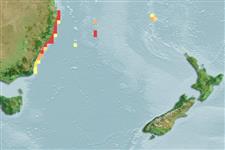>
Perciformes/Serranoidei (Groupers) >
Anthiadidae (Fairy basslets or Streamer basses)
Etymology: Caprodon: Latin, capra = goat + Greek, odous = teeth (Ref. 45335); krasyukovae: Named in honor of Z.V. Krasyukova, one of the authors of Fishes of the Sea of Japan and adjoining parts of the Yellow Sea (1969) (Ref. 43805).
Environment: milieu / climate zone / depth range / distribution range
Ecología
marino demersal; rango de profundidad ? - 55 m (Ref. 120532). Temperate
Western Pacific, Lord Howe Island region to southern Queensland and New South Wales.
Tamaño / Peso / Age
Maturity: Lm ? range ? - ? cm
Max length : 47.0 cm SL macho / no sexado; (Ref. 43805)
Short description
Claves de identificación | Morfología | Morfometría
Espinas dorsales (total) : 10; Radios blandos dorsales (total) : 21; Espinas anales: 3; Radios blandos anales: 8; Vértebra: 27. 15th-17th rays of the dorsal fin strongly elongated in relation to the other soft rays; caudal fin with deep notches above and below with very long median rays; vertebrae 27 (Ref. 43805).
Found on the continental shelf. Benthic (Ref. 75154).
Life cycle and mating behavior
Maturities | Reproducción | Spawnings | Egg(s) | Fecundities | Larva
Kharin, V.Y. and V.A. Dudarev, 1983. A new species of the genus Caprodon Temminck et Schlegel, 1843 (Serranidae) and some remarks on the composition of the genus. J. Ichthyol. 23(1):20-25. (Ref. 43805)
IUCN Red List Status (Ref. 130435)
Threat to humans
Harmless
Human uses
Herramientas
Special reports
Download XML
Fuentes de Internet
Estimates based on models
Preferred temperature (Ref.
123201): 20.2 - 23.3, mean 22.3 °C (based on 10 cells).
Phylogenetic diversity index (Ref.
82804): PD
50 = 0.6250 [Uniqueness, from 0.5 = low to 2.0 = high].
Nivel trófico (Ref.
69278): 3.7 ±0.5 se; based on size and trophs of closest relatives
Resiliencia (Ref.
120179): Bajo, población duplicada en un tiempo mínimo de 4.5-14 años (Preliminary K or Fecundity.).
Fishing Vulnerability (Ref.
59153): Moderate vulnerability (43 of 100).
